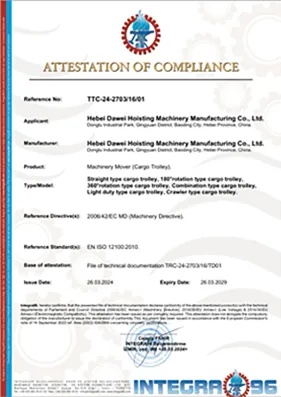Exploring the Advantages and Applications of Gantry Girder Cranes in Modern Industry
Understanding Gantry Girder Cranes A Comprehensive Overview
Gantry girder cranes are essential pieces of equipment in various industries, particularly in construction, manufacturing, and shipping. These cranes are designed to lift and move heavy materials with precision and efficiency. Unlike traditional overhead cranes, gantry cranes are supported by vertical legs that move along tracks, which allows for greater flexibility in their application. This article explores the design, functionality, advantages, and applications of gantry girder cranes.
Design and Structure
A typical gantry girder crane consists of a bridge-like structure formed by one or more girders. The main components include the gantry frame, hoist mechanism, and supporting legs. The girders typically span a significant distance and are supported on upright frames or legs, creating a rigid structure capable of bearing heavy loads. These cranes can be designed in multiple configurations—single girder, double girder, or even cantilever styles—to accommodate various lifting requirements. The structure is usually made from high-strength steel to provide durability and stability under considerable stress.
Functionality
Gantry girder cranes operate on a simple yet effective principle. The hoist mechanism, typically located on the bridge, can move horizontally across the girders, while the legs can travel along tracks to extend the working range of the crane. The lifting mechanism is often electric but may also be hydraulic, depending on the application. The versatility of gantry cranes allows them to be used in outdoor as well as indoor settings, making them ideal for loading and unloading containers, assembling large structures, or moving materials across a factory floor.
Advantages
gantry girder crane

One of the primary advantages of gantry girder cranes is their adaptability. They can be built to suit specific dimensions, requirements, and environments, which ensures they can handle diverse tasks. Moreover, since gantry cranes do not require fixed support structures like overhead cranes, they can be set up in various locations without extensive installation requirements. This flexibility is further enhanced by their mobility; many gantry cranes are designed to be easily transportable, allowing them to be moved between job sites as needed.
Additionally, gantry girder cranes often offer increased safety features. With improved control systems, operators can maneuver loads with precision, reducing the risk of accidents or damage to the materials being handled. Many cranes are equipped with failsafe mechanisms and overload sensors, ensuring the safety of both the workers and the equipment.
Applications
The applications of gantry girder cranes are numerous and varied. In manufacturing and assembly operations, they are commonly used for lifting heavy machine components or raw materials. In construction, they facilitate the movement of heavy building materials, saving time and labor costs. In maritime settings, gantry cranes are pivotal in loading and unloading shipping containers, enhancing the efficiency of port operations.
Moreover, in the automation and robotics sector, gantry cranes serve as integral components of assembly lines and automated systems, streamlining production processes. Their versatility and ability to handle heavy loads make them invaluable in industries ranging from aerospace to automotive.
Conclusion
In conclusion, gantry girder cranes play a significant role across different sectors due to their robust design, operational flexibility, and safety features. As industries continue to evolve, the demand for efficient material handling solutions like gantry cranes will only increase. Investing in modern gantry crane technology can lead to enhanced productivity, improved safety, and significant cost savings, making them a critical asset in today’s industrial landscape.
-
the-power-of-trolley-cargo-and-machinery-moving-solutionsNewsAug.22,2025
-
exploring-magnetic-lifting-devices-for-efficient-steel-plate-handlingNewsAug.22,2025
-
the-essential-guide-toportal-craneNewsAug.22,2025
-
enhancing-efficiency-in-permanent-magnetic-liftersNewsAug.22,2025
-
heavy-duty-machinery-movers-and-material-handling-solutionsNewsAug.22,2025
-
the-comprehensive-guide-to-adjustable-gantry-cranesNewsAug.22,2025
-
The Ultimate Guide to Heavy Machinery Moving EquipmentNewsAug.04,2025
